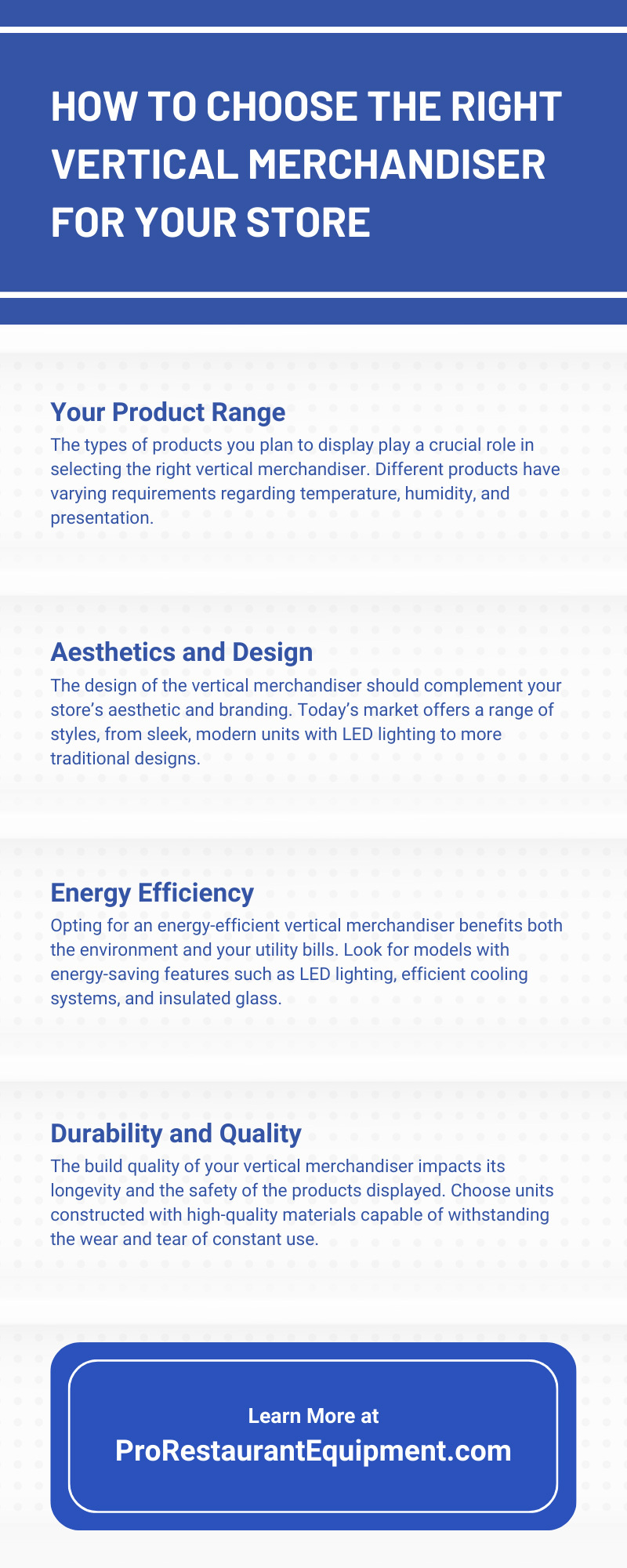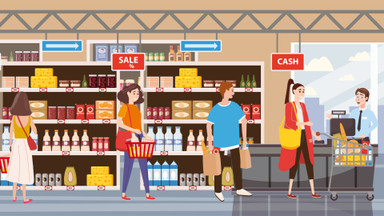Mar 18th 2024
How To Choose the Right Vertical Merchandiser for Your Store
Before diving into the many options of vertical merchandisers, you must thoroughly assess your store’s available space. The physical dimensions of your premises will largely dictate the size and type of merchandiser you can accommodate. Measure the designated area accurately, considering the floor space and the vertical clearance.
Adequate space ensures a good fit and facilitates better customer flow around the merchandiser, enhancing the shopping experience. Read on to discover more about how to choose the right vertical merchandiser for your store.
Your Product Range
The types of products you plan to display play a crucial role in selecting the right vertical merchandiser. Different products have varying requirements regarding temperature, humidity, and presentation. For instance, perishable goods like dairy or fresh produce may require refrigerated units with specific temperature controls, while non-perishable items might be best showcased in non-refrigerated, open-shelving units.
Aesthetics and Design
The design of the vertical merchandiser should complement your store’s aesthetic and branding. Today’s market offers a range of styles, from sleek, modern units with LED lighting to more traditional designs. The visual appeal of your merchandiser can attract customers and enhance their shopping experiences. Consider the merchandiser’s color, material, and lighting options in the context of your store’s design theme.
Energy Efficiency
Opting for an energy-efficient vertical merchandiser benefits both the environment and your utility bills. Energy consumption can be significant, especially for refrigerated units. Look for models with energy-saving features such as LED lighting, efficient cooling systems, and insulated glass. Energy Star-rated models or those with other environmental certifications can offer long-term savings and support your store’s sustainability goals.
Durability and Quality
The build quality of your vertical merchandiser impacts its longevity and the safety of the products displayed. Choose units constructed with high-quality materials capable of withstanding the wear and tear of constant use. Stainless steel, tempered glass, and commercial-grade plastics offer durability and ease of maintenance. A well-built merchandiser also maintains consistent temperature and humidity levels as needed, ensuring your products remain fresh.
Temperature Control and Versatility
For perishable goods, precise temperature control is essential. Select a vertical merchandiser with adjustable temperature settings that cater to different product types. Some advanced models offer versatile zones within the same unit, allowing for storing various products at their ideal temperatures. This versatility can be particularly useful for stores with limited space but a diverse product range.
Ease of Maintenance
Regular cleaning and maintenance are crucial for the hygiene and smooth operation of your merchandiser. Choose models designed for easy cleaning, with removable shelves and accessible compartments. Additionally, consider the ease of servicing; units that are common and have readily available spare parts can be repaired quickly, minimizing downtime.
Security Features
Security is a vital consideration, especially for high-value items. Look for vertical merchandisers with lockable doors or security-enabled access. This feature is particularly important for stores in high-traffic areas or where the merchandiser will be placed near an entrance or exit.
Brand Reputation and Warranty
The manufacturer’s reputation can provide valuable insight into the quality and reliability of the vertical merchandiser. Opt for brands with positive reviews and a track record of customer satisfaction. Additionally, consider the warranty offered with the unit. A comprehensive warranty can provide peace of mind, covering potential repairs or replacements.
Customer Accessibility
The primary goal of a vertical merchandiser is to showcase products in an accessible and appealing way. Ensure that your unit is customer-friendly, with easy-to-open doors or pull-out shelves. The height of the shelves should accommodate a wide range of customers.
Lighting and Visibility
Good lighting is essential for highlighting your products attractively. LED lighting is a popular choice due to its brightness and efficiency. Ensure the lighting system evenly illuminates all products without creating shadows or glare, which can detract from their appearance.
Adaptability and Expansion
In today’s ever-evolving market, the ability for store fixtures to adapt to changing needs is invaluable. When choosing a vertical merchandiser, consider its capacity for expansion or reconfiguration. Modular designs, which allow for easy shelf height and placement adjustments, offer the flexibility to accommodate different product sizes or seasonal inventory changes.
Additionally, some models come with add-on units, enabling you to expand your display area without investing in a completely new system. This adaptability ensures that your merchandising solution can grow alongside your business, providing a long-term return on investment.
Integration With Store Layout
The strategic placement of your vertical merchandiser within your store’s layout is critical for maximizing its effectiveness. It should enhance, not hinder, the natural flow of customer traffic. Placement near the store’s entrance can attract attention and draw customers, while positioning the merchandiser near complementary products can encourage additional purchases.
Consider sight lines from various entry points and ensure that your merchandiser does not obstruct views of other key areas or products. Effective integration involves balancing visibility with accessibility, ensuring customers can easily interact with the products on display.
Price and Budget Considerations
Budgeting for a vertical merchandiser requires a careful balance between initial costs and potential benefits. While higher-end models may offer advanced features like energy-efficient cooling systems or superior build quality, evaluating whether these features justify the additional expense based on your specific needs is important.
Consider the operational savings that certain features might provide, such as lower energy bills or reduced maintenance costs, against the unit’s upfront price. Financing options or leasing may also be available for businesses looking to minimize initial outlays. Ultimately, choose a merchandiser that offers the best value for your investment, considering both short-term costs and long-term savings.
Consumer Trends
Staying attuned to consumer trends is essential when selecting a vertical merchandiser. Today’s shoppers are increasingly looking for experiences that are convenient yet immersive. They value transparency, sustainability, and quality. Choose a merchandiser that allows your products to be the stars of the store—clear visibility, easy access, and appealing presentation are key.
Consider units with eco-friendly materials and energy-saving features that appeal to environmentally conscious consumers. Adapting your merchandising strategy to reflect consumer preferences can set your store apart, fostering loyalty and encouraging repeat business.
Now that you know how to choose the right vertical merchandiser for your store, remember that sourcing your merchandiser from a reputable provider of professional restaurant equipment can offer additional benefits. These suppliers often have a wide selection of high-quality units and can provide expert advice tailored to your needs.


